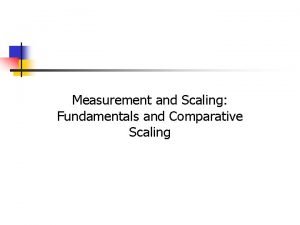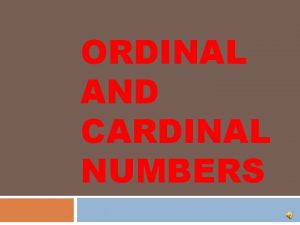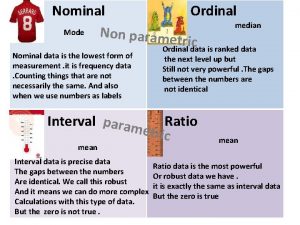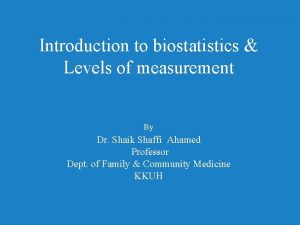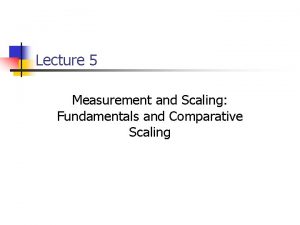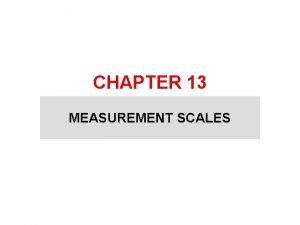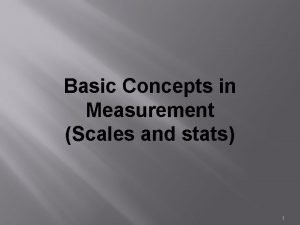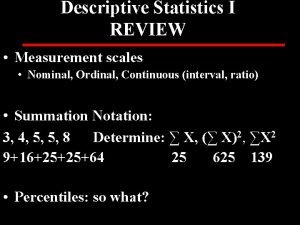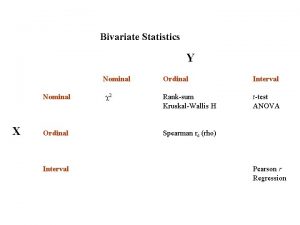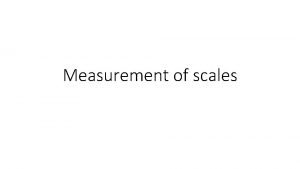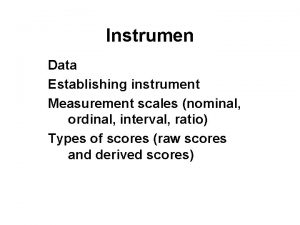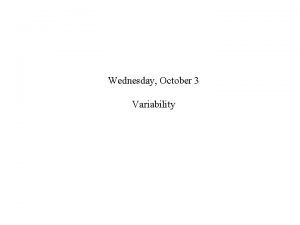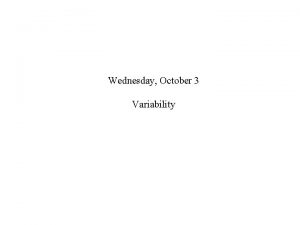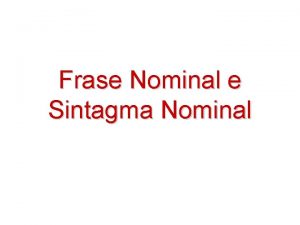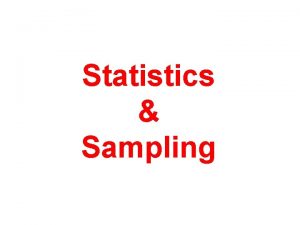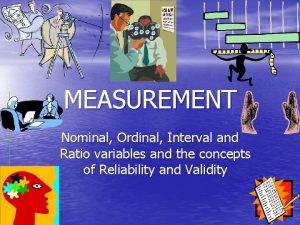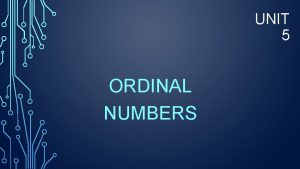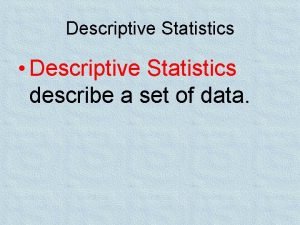Descriptive Statistics I REVIEW Measurement scales Nominal Ordinal




















- Slides: 20

Descriptive Statistics I REVIEW • Measurement scales • Nominal, Ordinal, Continuous (interval, ratio) • Summation Notation: 3, 4, 5, 5, 8 Determine: ∑ X, (∑ X)2, ∑X 2 9+16+25+25+64 25 625 139 • Percentiles: so what?

• Measures of central tendency • Mean, median mode • 3, 4, 5, 5, 8 • Distribution shapes

Variability • Range Hi – Low scores only (least reliable measure; 2 scores only) • Variance (S 2) Spread of scores based on the squared deviation of each score from mean Most stable measure Error True Varia nce • Standard Deviation The square root of the variance Most commonly used measure of variability Total variance

Variance (Table 3. 2) The didactic formula 4+1+0+1+4=10 5 -1=4 10 = 2. 5 4 The calculating formula 55 - 225 = 55 -45=10 = 2. 5 5 4 4 4

Standard Deviation The square root of the variance Nearly 100% scores in a normal distribution are captured by the mean + 3 standard deviations

The Normal Distribution M + 1 s = 68. 26% of observations M + 2 s = 95. 44% of observations M + 3 s = 99. 74% of observations

Calculating Standard Deviation Raw scores (X-M) 3 -1 7 3 4 0 5 1 1 -3 ∑ 20 0 Mean: 4 (X-M)2 1 9 0 1 9 20 S= √ 20 5 S= √ 4 S=2

Coefficient of Variation (V) Relative variability around the mean OR Determines homogeneity of scores S M Helps more fully describe different data sets that have a common std deviation (S) but unique means (M) Lower V=mean accounts for most variability in scores. 1 -. 2=homogeneous >. 5=heterogeneous

Descriptive Statistics II • What is the “muddiest” thing you learned today?

Descriptive Statistics II REVIEW Variability • Range • Variance: Spread of scores based on the squared deviation of each score from mean Most stable measure • Standard deviation Most commonly used measure Coefficient of variation • Relative variability around the mean (homogeneity of scores) • Helps more fully describe different data sets that have a common std deviation (S) but unique means (M) 50+10 • What does this tell you?

Standard Scores • Set of observations standardized around a given M and standard deviation • Score transformed based on its magnitude relative to other scores in the group • Converting scores to Z scores expresses a score’s distance from its own mean in sd units • Use of standard scores: determine composite scores from different measures (bball: shoot, dribble); weight?

Standard Scores • Z-score M=0, s=1 • T-score T = 50 + 10 * (Z) M=50, s=10

Conversion to Standard Scores Raw scores 3 7 4 5 1 • Mean: 4 • St. Dev: 2 X-M -1 3 0 1 -3 Z -. 5 1. 5 0. 5 -1. 5 SO WHAT? You have a Z score but what do you do with it? What does it tell you? Allows the comparison of scores using different scales to compare “apples to apples”

Normal distribution of scores Figure 3. 7 99. 9

Normal-curve Areas Table 3 -3 • Z scores are on the left and across the top • Z=1. 64: 1. 6 on left , . 04 on top=44. 95 • Values in the body of the table are percentage between the mean and a given standard deviation distance • The "reference point" is the mean


Area of normal curve between 1 and 1. 5 std dev above the mean Figure 3. 9

Normal curve practice • • Z score Z = (X-M)/S T score T = 50 + 10 * (Z) Percentile P = 50 + Z percentile (+: add to 50, -: subtract from 50) Raw scores • Hints • Draw a picture • What is the z score? • Can the z table help?

• Assume M=700, S=100 Percentile T score z score Raw score 64 53. 7 . 37 737 43 – 1. 23 618 17 68 68 835. 57

Descriptive Statistics III • Explain one thing that you learned today to a classmate • What is the “muddiest” thing you learned today?
 Ordinal measurement scale
Ordinal measurement scale Nominal ordinal intervalo razon
Nominal ordinal intervalo razon Cardinal vs ordinal
Cardinal vs ordinal Nominal vs ordinal data
Nominal vs ordinal data Preguntas escala nominal
Preguntas escala nominal Ordinal data examples
Ordinal data examples Nominal ordinal intervalo razon
Nominal ordinal intervalo razon Interval scale example
Interval scale example Nominal ordinal
Nominal ordinal Nominal, ordinal, discrete, continuous
Nominal, ordinal, discrete, continuous Types of error in measurement
Types of error in measurement Primary scales of measurement
Primary scales of measurement Types of scales in educational measurement
Types of scales in educational measurement Measurement scales in research
Measurement scales in research Attitude scale
Attitude scale Measurement scales in research
Measurement scales in research Primary scales of measurement in marketing research
Primary scales of measurement in marketing research Types of measurement scales
Types of measurement scales 4 measurement scales
4 measurement scales Property of moreness
Property of moreness 4 measurement scales
4 measurement scales
